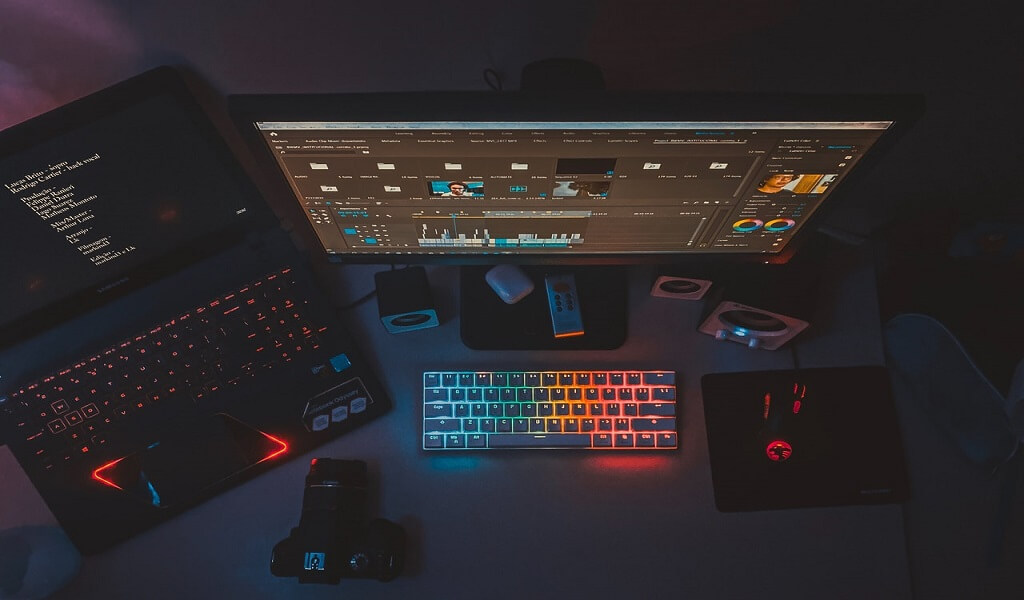The beauty of connecting multiple monitors is the efficiency of working on several documents or tabs simultaneously. Multiple monitors play a critical role in improving the working experience in a work or trading station by increasing productivity.
In the past, graphic cards could only hold a single output at any given time. Fortunately today, graphic cards can handle more monitors, depending on the type. You need a prebuilt trading station with a 6 monitor setup to have things flowing smoothly.
Getting a good graphics card for a multiple monitor setup or more is very difficult. Wondering why this is the case? Most graphic cards have a provision of between 2 to 4 outputs. This means that if you are to do more than a 6 monitor setup, it is difficult. Well, unless you consider the following options:
Use of Multiple Graphics Cards
Most computer motherboards have extra ports to support the use of multiple graphics cards. Graphics card manufacturers have increased the video outputs on each card from 2 up to 6. With this provision, it is possible to run 6 or more monitors simultaneously.
This means that with a 3 physical output card (EVGA GEFORCE GT710), you can use two to run a 6 monitor set-up. Alternatively, if you have a 4 physical output card (QUADRO K1200), you can run 6 to 8 monitors using two of the graphic cards.
The VISIONTEK 7750 graphics card can handle up to 6 monitors. It has 6 physical outputs which run 6 monitors. Alternatively, you can use two of them to run 7-12 monitors.
However, before you decide to buy more graphic cards to meet your monitors’ needs, you have to ensure that your PC can handle them. This means that the slots on your PC have enough space. Its power supply unit can manage the extra load.
In addition, the graphics card you buy should be similar to your existing one or at least have the same features. Multiple graphic cards perform better together if they are similar by type.
Multi-Stream Transport (MST Hub)
The MST hub functions by splitting the DisplayPort 1.2 video signal from the source PC and rerouting each video signal to the display monitors. The MST configuration has a DisplayPort. This further splits into VGA and HDMI converters.
These connect to the extra monitors on display. The signal received by each monitor is independently routed hence the operating system sees them as separate. The monitors, therefore, function as extended desktop devices.
The advantage with the MST configuration system is that you can use monitors that are not necessarily DisplayPort 1.2 enabled or non-HDMI, DVI or VGA enabled. All you need is the DisplayPort to HDMI/VGA/DVI converters and you are good to go.
The other good thing is that newer versions of devices such as Microsoft Pro 2 and 3 tablets support MST. What’s more, even with a USB 3.0 port, you can connect your monitors. This is as long as you have an external video card adapter.
Daisy Chaining
In case you are wondering what “Daisy Chaining” is, it refers to the ability to link multiple monitors together. This is via a cable connection using a standard DisplayPort 1.2. The multiple connected monitors are each supposed to have DisplayPort 1.2 receivers and transmitters; except for the last monitor in the chain.
The last monitor is usually connected directly to the source (PC) which makes the monitors appear as separate display screens. This, therefore, means that the ‘daisy-chained’ monitors each receive the audio-visual signal independently.
There are a limited number of graphic cards that are able to support a 6 monitor setup or more. Most graphics cards have less video display outputs. They use DisplayPort 1.2 to connect monitors via daisy chain. Also, they connect two graphics cards or use MST hubs.
One disadvantage with the daisy chain and MST hub is reduced quality of video resolution with more monitor use. Secondly, these options come with extra investment. You’ll have to upgrade your PC or buy extra hardware to make it happen.
Final Thoughts:
If you are looking to run a 6 monitor setup in a less expensive way, you should consider the VISIONTEK 7750. This graphics card has 6 ports for every monitor; hence maintaining a high resolution for all of them. The beauty of it all is that each of your monitors can function at varying resolutions, response times and operate with varying color controls.
While we are yet to see video cards that run more than 6 monitor setup systems, there is the new Matrox M9188. It can run 8 monitors at a go or use more than one card to run up to 24 monitors. This new specialty graphics card is very expensive hence is ideal for mission-oriented environments like police information centers and commercial centers.
If money is not an issue for you, then this new development could work for you. Otherwise, just go for the VisionTek 7750 and use two or three of them to run whichever number of monitors you have.

















